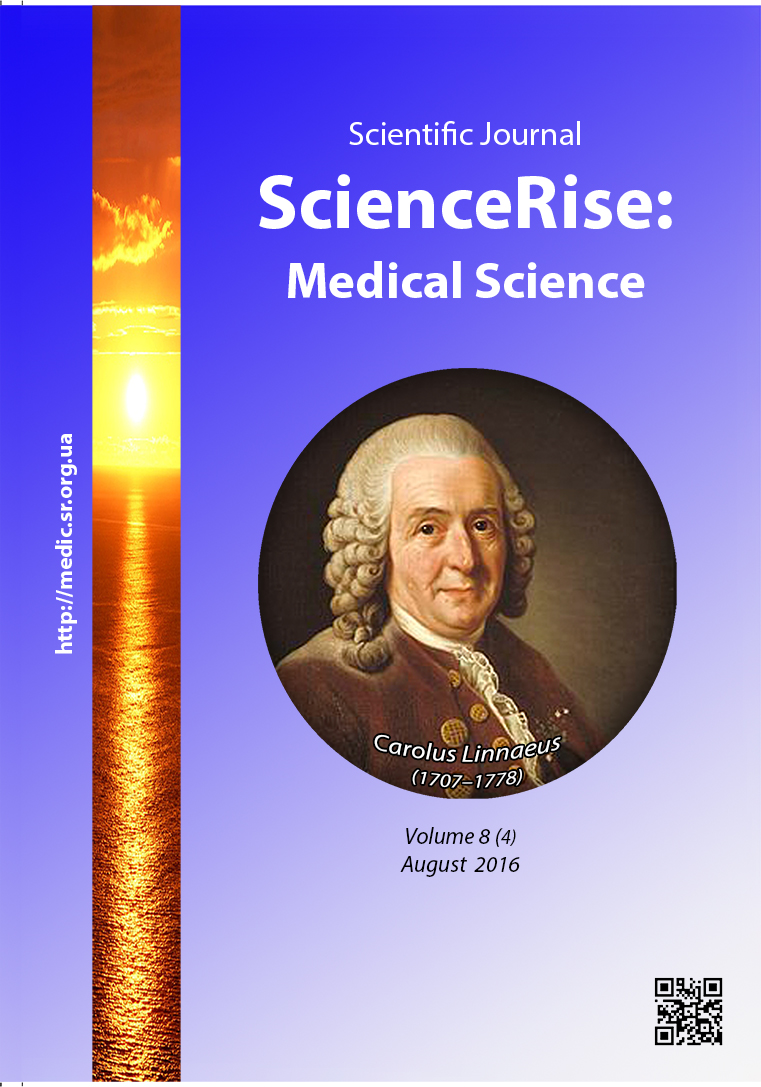Characteristic of correlation between post-stroke spasticity and clinical and paraclinical features of ischemic stroke
DOI:
https://doi.org/10.15587/2519-4798.2016.76555Keywords:
post-stroke spasticity, correlations, pathogenetic stroke subtypes, exciting and brake neurotransmittersAbstract
The aim of research was to study the correlation between the intense of post-stroke spasticity and certain clinical (severity of stroke in most acute period, pathogenetic subtype of stroke, localization of ischemia zone) and paraclinical )sex, smoking in anamnesis, content of exciting and braking neurotransmitters) factors.
Methods. The research included 97 patients with the first ischemic stroke. During the 6th month patients were divided in 2 groups: the ones with post-stroke spasticity and without it. For determination of reliable correlation between the intensity of spasticity and clinical and paraclinical factors the non-parametric correlation coefficient of Kendall range (τ) was used.
Results. In the research we observed the reliable positive correlation between spasticity after stroke and the severity degree of ischemic stroke, smoking in anamnesis, localization of stroke in carotid basin and the level of glutamate and aspartate in the most acute period of stroke. It was also revealed the negative correlation of the middle force between the spasticity intensity and glycine and taurine content in the most acute period of ischemic stroke.
Conclusions. The revealed correlations between the spasticity degree and clinical and paraclinical parameters can be further used for elaborations of development predicators of spastics and the study of preventive treatmentReferences
- Golovchenko, U. I., Treshchinskaya, M. A. (2009). Prophylaktika insylta. Kyiv, 36.
- Murashko, N. K., Afanasev, V. V., Rumyanceva, C. Y., Sulik, R. V. (2013). Gostri porushennya mozkovogo krovoobigu: diagnostuka i likuvannya. Kyiv, 35.
- Nikolaev, S. G. (2013). Elektromiographyya: klinicheskiy praktikum. Ivanovo: PresSto, 393.
- Mishchenko, T. S., Shestopalova, L. F., Trishunka, M. A. (2008). Klinichni shkalu i psychodiagnostuchni testu y diagnostuzi sydunnuch zahvoryvan holovnogo mozky. Kharkiv, 36.
- Wissel, J., Manack, A., Brainin, M. (2013). Toward an epidemiology of poststroke spasticity. Neurology, 80 (3), S13–S19. doi: 10.1212/wnl.0b013e3182762448
- Tkachenko, O. V., Zoha, I. O. (2010). Ishemichnuy insult. Musteztvo likuvatu, 6 (72), 52–58.
- Flomin, U. V., Gulaeva, M. V., Samosuk, N. I. et. al. (2014). Lechenie insulta v stazionare: kluchevue factoru, opredelyaushchie ishodu bolezni. Mizhnarodnuj nevrologichnuj jurnal, 7 (69), 46–57.
- Mehrholz, J., Major, Y., Meißner, D., Sandi-Gahun, S., Koch, R., Pohl, M. (2005). The influence of contractures and variation in measurement stretching velocity on the reliability of the Modified Ashworth Scale in patients with severe brain injury. Clinical Rehabilitation, 19 (1), 63–72. doi: 10.1191/0269215505cr824oa
- Lundström, E., Smits, A., Terént, A., Borg, J. (2010). Time-course and determinants of spasticity during the first six months following first-ever stroke. Journal of Rehabilitation Medicine, 42 (4), 296–301. doi: 10.2340/16501977-0509
- Faist, M., Mazeret, D., Dietz, В., Pierrot-Deseilligy, E. (2010). Tension development and muscle activation in the leg during gait in spastic hemiparesis; independence of muscle hypertonia and exaggerated stretch reflexes. Brain, 117, 1449–1455.
- Nguyen, T. T. H., Bhattarai, J. P., Park, S. J. Han, S. K. (2013). Activation of Glycine and Extrasynaptic GABAAReceptors by Taurine on the Substantia Gelatinosa Neurons of the Trigeminal Subnucleus Caudalis. Neural Plasticity, 2013, 1–12. doi: 10.1155/2013/740581
- Foran, J. R., Steinman, S., Barash, I., Chambers, H. G., Lieber, R. L. (2005). Structural and mechanical alterations in spastic skeletal muscle. Developmental Medicine & Child Neurology, 47 (10), 713–717. doi: 10.1111/j.1469-8749.2005.tb01063.x
- Lance, J. W.; Feldman, R. G., Young, R. R., Koella, W. P. (Eds.) (1980). Symposium in Spasticity: Disorders Motor Control. Chicago Tear Book Medical Pubs, 485–495.
- Watkins, C., Leathley, M., Gregson, J., Moore, A., Smith, T., Sharma, A. (2002). Prevalence of spasticity post stroke. Clinical Rehabilitation, 16 (5), 515–522. doi: 10.1191/0269215502cr512oa
- Okamoto, K., Kimura, H., Sakai, Y. (1983). Taurine-induced increase of the Cl-conductance of cerebellar Purkinje cell dendrites in vitro. Brain Research, 259 (2), 319–323. doi: 10.1016/0006-8993(83)91266-0
- Ward, A. B. (2002). A summary of spasticity management – a treatment algorithm. European Journal of Neurology, 9 (s1), 48–52. doi: 10.1046/j.1468-1331.2002.0090s1048.x
Downloads
Published
How to Cite
Issue
Section
License
Copyright (c) 2016 Анжеліка Володимирівна Паєнок, Ірина Миколаївна Мітельман

This work is licensed under a Creative Commons Attribution 4.0 International License.
Our journal abides by the Creative Commons CC BY copyright rights and permissions for open access journals.
Authors, who are published in this journal, agree to the following conditions:
1. The authors reserve the right to authorship of the work and pass the first publication right of this work to the journal under the terms of a Creative Commons CC BY, which allows others to freely distribute the published research with the obligatory reference to the authors of the original work and the first publication of the work in this journal.
2. The authors have the right to conclude separate supplement agreements that relate to non-exclusive work distribution in the form in which it has been published by the journal (for example, to upload the work to the online storage of the journal or publish it as part of a monograph), provided that the reference to the first publication of the work in this journal is included.









